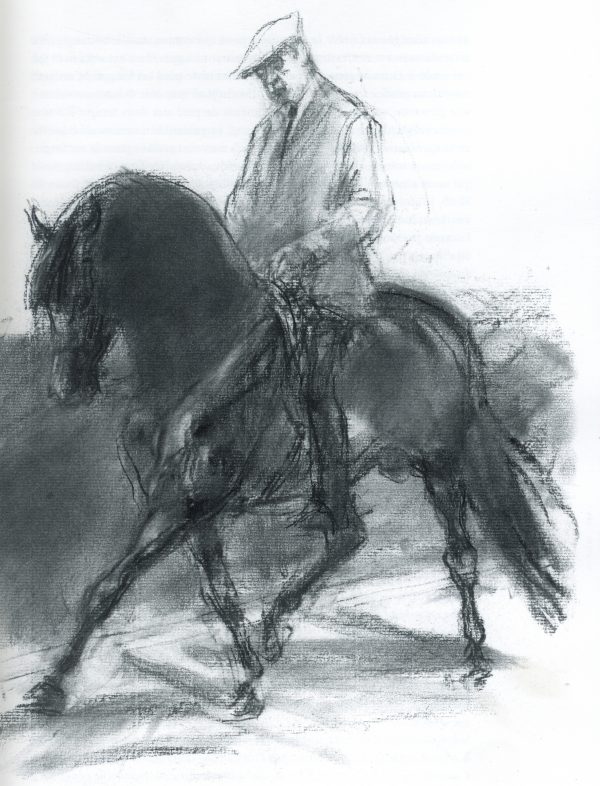
Illustration – Jean-Louis Sauvat
”Anything forced or misunderstood can never be beautiful … ”
The quotation applies today as much as it did in the time of Xenophon, and in particular perhaps, to that much misunderstood subject, the hands. The rein influence on the horse comes only after one has put the horse to the aids of the back, seat and legs. The hands are the fine instruments which talk to the horse and through the action of the bit maintain a polite conversation, telling him in which direction we wish him to go · and in what manner. They constitute the finishing touches to the picture – harmoniously channeling all the energy which our body and leg aids have created.
In this article, we are concerned with riding a mature horse on the flat, for the young, newly backed horse may require a slightly more forward position initially than that described in the classical seat series.
One does not need a Grand Prix dressage horse to ride elegantly and correctly; it is perfectly possible to strive towards attaining a classical seat on a perfectly ordinary riding school horse. With gentle persuasion, a positive feel for the subject, and the application of correct aids, a nose-poking plodder can be transformed, and unless there is something physically wrong with the horse, there is no such word as ‘can’t’!
It used to be said, you were not considered a good horseman or horsewoman, unless you were born with light, tactful hands. Good hands were the essence of good horsemanship and the highest compliment a serious horseman could receive was the remark- ‘he has wonderful hands’.
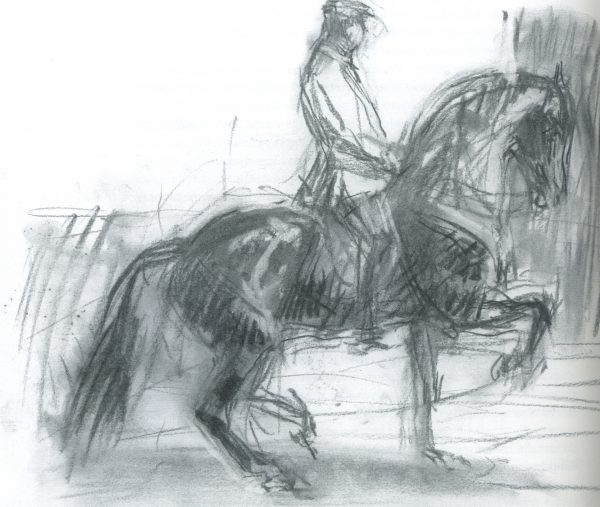
It went without saying of course that this rider would also have a good seat which included all that went with it – control, balance, energy and harmony. Such riders can work miracles on the most obstinate of horses.
Today, in the average riding lesson, less and less emphasis appears to be placed on how the hands are used. Instructors will take pains to establish the position of the rider’s hand in front of the saddle, but it is rare that one hears an explanation of how that position may be maintained and how the hands should be used. ‘Keep the hands light!’ ‘Talk to the horse through your fingers!’ ‘Play with the reins!’ Expressions such as these are helpful and immediately conjure up the need for artistry. Sadly nowadays it only seems to be the country’s top trainers – most of whom have trained abroad – who use them. Instead the emphasis is on establishing contact. There is nothing wrong with this in itself, but the manner in which this may be, and often is, interpreted is not only crude but sometimes little short of cruelty.
It is possible that this state of affairs can be blamed on the snaffle bit. The snaffle is excellent bit but it was originally designed for flat racing, or for use by stable boys who were deemed to be of insufficient education to be let loose with a ‘proper’ bit, ie. a double bridle. Now the snaffle has become the accepted bit of the day, many riders are lulled into a sense of false security, thinking they can do no harm to the horse’s mouth with a ‘mere’ snaffle.
When they do not achieve the degree of control they wish with the snaffle, instead of seeking help from outside, or considering the alternatives of a more exciting form of bridling such as the double bridle, they develop a see-sawing action with the hands in an attempt to obtain a correct head position in their horse. This can be extremely unpleasant and harmful for the horse, and an artificial head carriage brought about in such a way can permanently damage his back. From being a kind bit, the snaffle in the wrong hands can be transformed into an instrument of pure torture, particularly if it is thin and jointed. Pulling and see-sawing on the snaffle will rapidly bruise and deaden the bars of the horse’s mouth.
With certain pupils on certain horses I have often found the vulcanite pelham is a kinder bit; the two reins have the effect of making the rider think about his hands, instead of letting them hang onto the rein, like two dead weights. It is unfortunate that pupils are not made more aware of the pitfalls of bad hands. Television does not help when we see some of the most famous showjumping riders yanking at their horses’ mouths, and even in top level dressage competitions we observe some unpleasant sights largely caused by unyielding hands. Those riders who do use their hands artistically instead of punitively are sadly not always rewarded for their pains, the system of marking takes little account of the quality of riding; and accuracy – however it is achieved – takes precedence over all. Too little attention is paid therefore at grass roots level, and the result is too many horses with unhappy mouths.
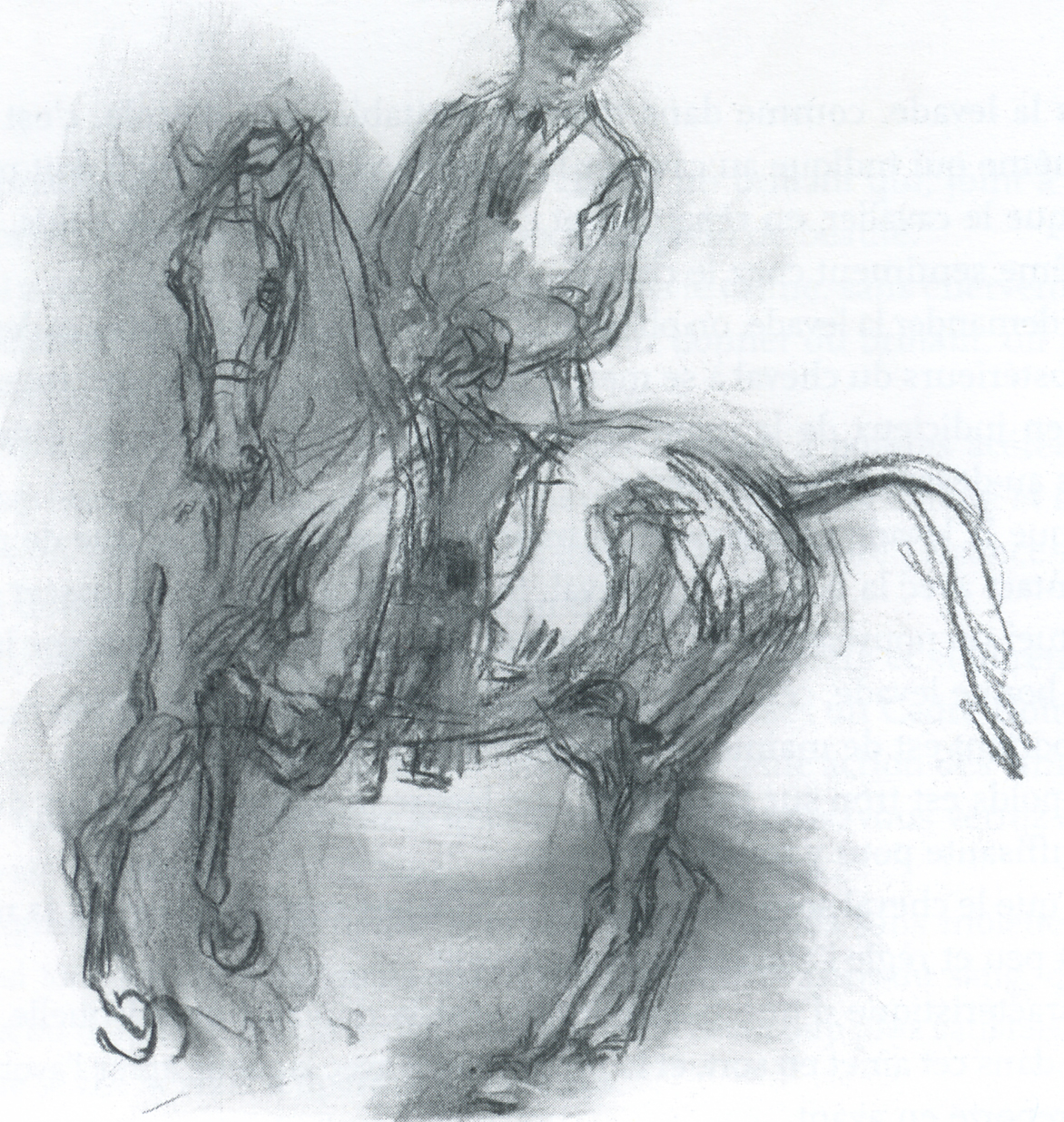
Much nonsense is talked about ‘contact’ and pupils often ask what is good contact. ‘Contact’ is quite simply the link between the rider’s hands and the mouth of the horse. It should be light and positive. In the well-schooled horse, the weight of the reins alone can bring about sufficient contact. In the young horse the contact will be a little stronger, although never more than two or three ounces and the contact is then maintained by pushing the horse up to the hands with seat, back and legs.
The hands should be continually thanking the horse for paying attention and obeying their requests. Taking must be followed by giving, and this continual interplay on the reins brought about by forearm, wrist and fingers is part of the ‘music’ that is played between horse and rider. Contact should never take the form of long, sustained pulls on the reins. If it does the horse will lean on the bit and become heavy on his forehand. As the horse is much stronger than the rider, the horse invariably wins a pulling match.
It is up to the rider to refine his rein technique to the point that he can invite the horse into doing what is required with a soft interplay on the reins. It is of course essential that the rider has established a good, firm seat before his hands are able to achieve the degree of control of which they are capable. But right from the beginning there is no excuse for heavy handedness. If we return to the basics and let gravity and commonsense take control, the worst errors can be avoided.

The perpendicular ‘earth’ line runs through the top of the head, ears, point of shoulder, elbow, point of hip and heel. A divergence from this line disturbs the correct balance.
Always think of the standing figure before the mounted figure and have a firm picture in the mind’s eye of what keeps that figure upright. Then transpose the image to the mounted figure. Little should alter. You do not have to be a riding expert to see that if for the majority of work the shoulders and elbows are kept within the direct gravity line, then there is no reason whatsoever why the forearm, wrist and hand should be heavy.
We all know that there should be an unbroken line from the horse’s mouth through the rein, through the hand, to the rider’s elbow, but what is rarely taught is that the more we move the elbow away from the rider’s side and towards the horse’s mouth, the heavier the hands tend to become. It takes a very real concentrated effort to keep the hands light once the elbow and upper arm are moved away from the natural line of gravity – for the body is no longer able to absorb the sheer weight of the upper arm and shoulder. (Fortunately, most exercises requiring a more forward position are short-lived, thus enabling the arm to return to its basic position).
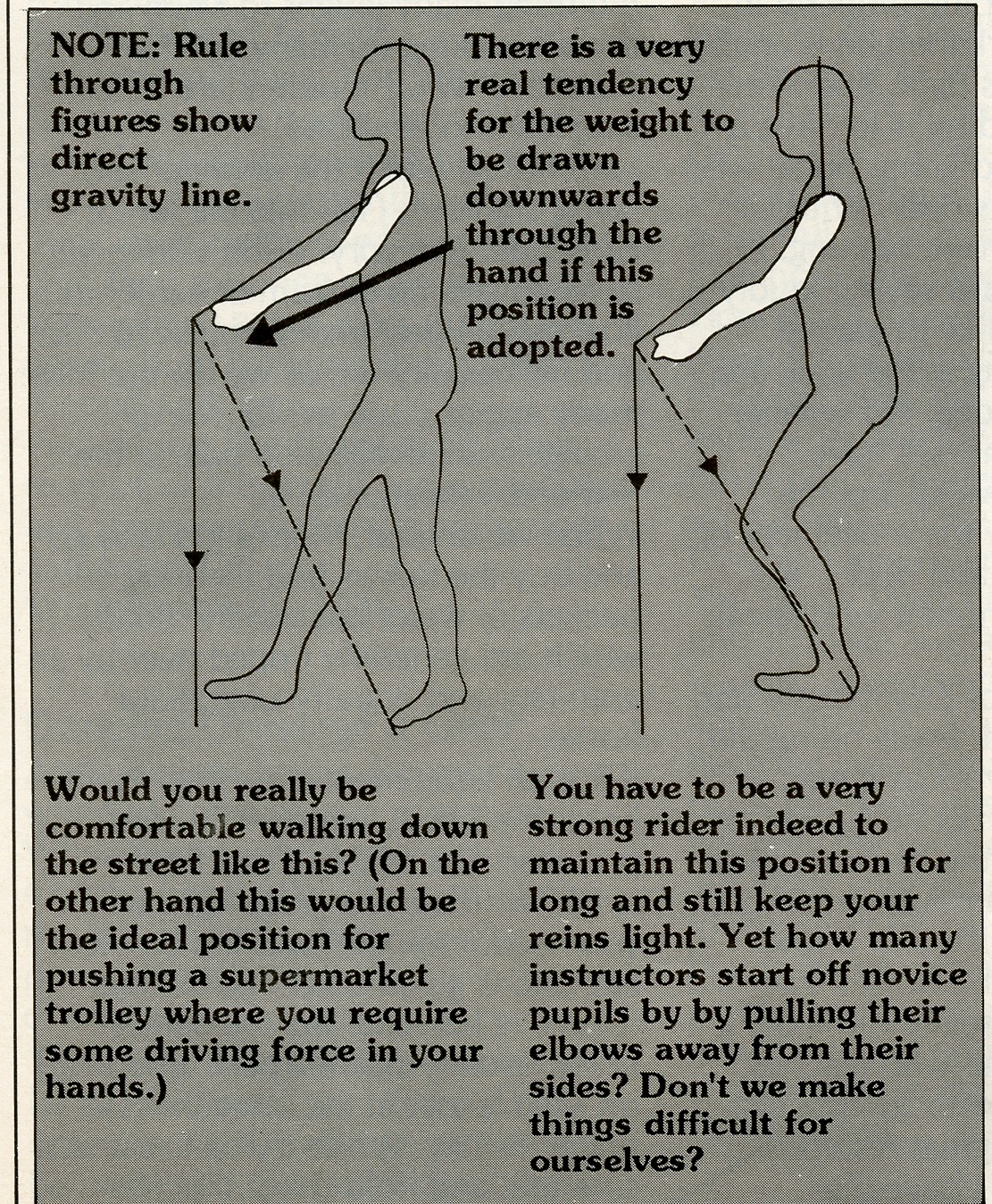
In seeking a good contact, which results in a responsive horse, lightness should be the most important ingredient. The effect of a light, asking hand should never be underestimated. There are two approaches to consider: Firstly, we should remember that riding is as much mental as it is physical. If one thinks of the hands as fine precision instruments, rather like the delicate, refined instruments a surgeon uses throughout an intricate operation, it helps enormously.

Secondly, when one considers that the body weight of the rider should be distributed evenly downwards in a central line as originally discussed in The Classical Seat, there should be no excuse for weight to diverge from its path into the hand. The hands simply cannot become heavy if this central weight/gravity line is maintained. And yet – almost paradoxically – the rider is in a much stronger position to use his hands firmly and effectively in an emergency situation.
So much of course is governed by FEEL, a point which I have stressed again and again. If we do not accept the simple mechanics of riding, we start off at a considerable disadvantage. Sadly, it is the simple mechanics which are rarely explained today. The definition of the classical seat should be as fundamental and as commonsense as possible. On occasions, I have hesitated to put certain observations into print in the belief that they are so obvious, the reading public might be insulted. Instead, I am told that this teaching and these explanations are so forthright as to be almost revolutionary!
In the teaching and execution of dressage today, it is almost as though the principal participants – with the exception of a notable few – wish to overload the subject in mystique and complicated technicality. This was never the aim of history’s true classical masters. From Xenophon to la Guérinière through to the 20th century Handler, the emphasis has always been on simplicity. Thus when discussing the subject of hands, we would do well to remind ourselves of an old Spanish proverb… “To ride is to aspire to gentleness – reins of silk”.
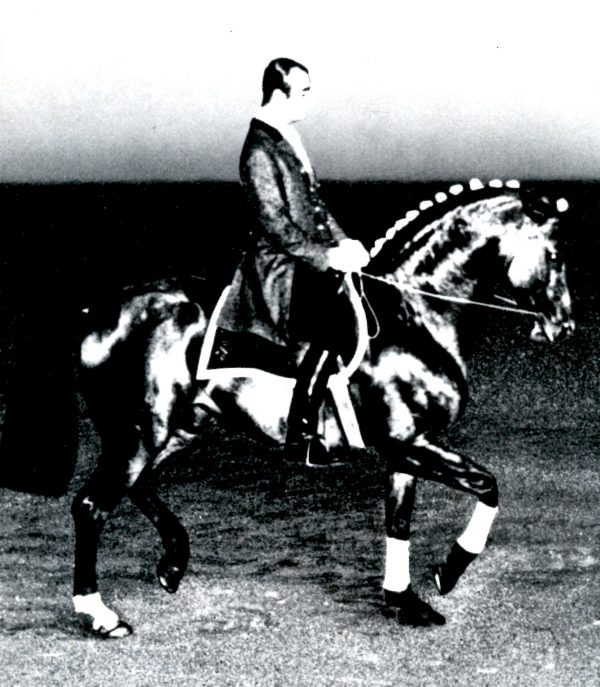
Nuno Oliveira, riding with a ribbon in the horse’s mouth. Sylvia Loch was British, and a pupil of Nuno’s.

Great article.
Really enjoyed your article. Thanks for sharing!
A good reminder to all instructors and riders . Excellent article